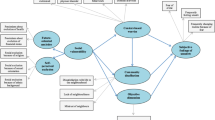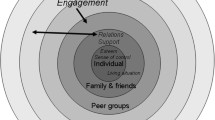Abstract
For a kind of inertia effect, today the Italian welfare state protects the older too much and, on the contrary, it does not counter sufficiently the new risks associated with other phases of life. Not much seems to be implemented in favour of Italian young people who, as a matter of fact, seem to suffer a lot from the present changes: young people remain longer in the parental home and postpone setting up their own independent life to a most advanced age. In order to understand the situation of vulnerability increasingly widespread among young people, it seemed more and more necessary an in-depth analysis of the reasons and the subjective status of the discomfort that affects young people because of a delayed transition into adulthood. Therefore, we studied the self-perceived vulnerability situation experienced by Italian young people in different spheres of their life. The aim was to understand what is the subjective status that prevents young people from planning an adult life, having a partner and possibly having a child. In particular our analysis tries to bring together theoretical and methodological methods in the measurement of socio-demographic vulnerability concept. In order to do that, we employed the Multiple Correspondence Analysis, using data provided by the Italian Multipurpose Survey, carried out in 2003 and named “Household and Social Actors”.



Similar content being viewed by others
Notes
We talk of a “process” because there exist strong internal connections in this phenomenon, as each step is a premise or a consequence of the following one. As a matter of fact, the progressive shifting of the age when young people accomplish their education, enter labour market, choose and maybe buy a house (typical phenomenon of our country), leave their family of origin and start an adult affective life, do have effects on the other spheres of the life of young people.
Italian young people live longer in their family of origin and postpone starting an independent life to an older age (Istat 2006). The percentage of Italian young people living with their parents, although it decreases as they get older, has extraordinarily grown: the group of unmarried young men and women aged 25–34 and still living in their family of origin has passed from 35.5 to 43.3% from 1995 to 2005, going beyond the number of their peers cohabiting with a partner and their children (who, on their turn, have decreased from 40 to 29.4%).
The 2008 Family and Social Actors survey is still not available at the moment of the writing of this paper.
Considering that, in general, Italy is characterized by a high level of homogamy between the parents of a family and that, if not, it is the father who has a higher level of education, we thought that the educational level and employment status of the mother could better discriminate the situation experienced by different young people in their different families.
As proportions of missing answers for that variables are fairly high, we performed a deletion of respondents with missing data, since we do not want to deal with the further complicating issue of missing data. This reduces the original sample by about 17% and leaves around 10,000 respondents providing complete data on subjective vulnerability.
Considering that the multiple response question has 16 possible responses, the proportions of missing answers is quite high, and as it will be explained in the following these variables are not apt to be included actively in the multiple correspondence analysis.
In case of the large sample size is easy that the chi-squared test always reject the null hypothesis of independence.
Note that the interpretation of the multiple correspondence analysis is often based on proximities between points in a dimensional map (i.e., two or three dimensions). Proximities are important only between points from the same set (i.e., rows with rows, columns with columns) and, in particular when two row points are close to each other, they tend to select the same levels of variables. Therefore, the proximity between levels of different variables means that these levels tend to appear together in the observations, while the proximity between levels means that the groups of observations associated with these two levels themselves are similar.
References
Aassve, A., Iacovou, M., & Mencarini, L. (2005). Youth poverty in Europe: What do we know? Working papers of the institute for social and economic research, 2/2005. Colchester: University of Essex, from: http://www.iser.essex.ac.uk/pubs/workpaps/pdf/2005-02.pdf.
Aassve, A., Iacovou, M., & Mencarini, L. (2006). Youth poverty and transition to adulthood in Europe. Demographic Research, 15(2), 21–50.
Adger, W. N. (2006). Vulnerability. Global Environmental Change, 16, 268–281.
Adger, W. N., & Winkels, A. (2006). Vulnerability, poverty and sustaining well-being. In G. Atkinson, S. Dietz, & E. Neumayer (Eds.), Handbook of sustainable development (pp. 189–204). Elgar: Cheltenham.
Alwang, J., Siegel, P. B., & Jørgensen, S. L. (2001). Vulnerability: A view from different disciplines. Social Protection Discussion Paper, 115. Washington, DC: The World Bank. http://www.worldbank.org/sp.
Balisacan, A. M., & Fuwa, N. (2007). Poverty and vulnerability. In A. M. Balisacan & N. Fuwa (Eds.), Reasserting the rural development agenda: Lessons learned and emerging challenges in Asia. Los Baños, Philippines: SEARCA.
Benzecri, J. P. (1973). L’analyse Des Donnees. Tome II: L’analyse Des Correspondances. Paris: Dunod.
Billari, F. C. (2000). L’analisi delle biografia e la transizione allo stato adulto. Aspetti metodologici e applicazioni ai dati della Seconda Indagine sulla fecondità italiana. Padova: Cleup Editore.
Caritas Italiana & Fondazione Zancan di Padova. (2004). Vuoti a perdere. Rapporto 2004 su esclusione sociale e cittadinanza incompiuta. Milano: Edizioni Feltrinelli.
Castel, R. (1997). Disuguaglianze e vulnerabilità sociale. Rassegna Italiana di Sociologia, I/1997, 41–56.
Castel, R. (2004). L’insicurezza sociale. Che significa essere protetti? Torino: Einaudi (trad. it. da Castel R. (1995) Métamorphoses de la question sociale, Fayard, Paris).
Cavalli, A., & de Lillo, A. (1988). Giovani anni ‘80. Bologna: il Mulino.
Clausen, S. E. (1998). Applied correspondence analysis. An introduction, series: Quantitative applications in the social sciences. London: Sage.
ECLAC (Economic Commission for Latin America and the Caribbean). (2002). Socio-demographic vulnerability: Old and new risks for communities, households and individuals (LC/G.2170(SES.29/16)). (Santiago, Chile: ECLAC).
EUROSTAT. (2002). Income, poverty and social exclusion: Second report, European social statistics (pp. 76–92). Luxembourg: EUROSTAT.
Fahmy, E. (2002). Youth, poverty and social exclusion. Working paper 27, townsend centre for international poverty research. Bristol: University of Bristol, from: http://www.bristol.ac.uk/sps/research/cpsj/staff/fahmy.shtml.
Ferrera, M. (2004). Ricalibrare il modello sociale europeo. Accelerare le riforma, migliorare il coordinamento. Working paper 7/2004, Milano: Università degli Studi di Milano, from: http://users.unimi.it/ferrera/upload/download/it/wp/Riformare_il_modello_sociale_europeo.pdf.
Greenacre, M. J. (1984). Theory and applications of correspondence analysis in practice. London: Academic Press.
Greenacre, M. J. (1991). Interpreting multiple correspondence analysis. Applied Stochastic Models and Data Analysis, 7, 195–210.
Greenacre, M. J. (2005). From correspondence analysis to multiple and joint correspondence analysis. Economics working papers, 883. Barcellona: Universitat Pompeu Fabra.
Istat. (2006). Strutture familiari e opinioni su famiglia e figli. Indagine multiscopo sulle famiglie. Famiglia e soggetti sociali. Anno 2003. Collana “Informazioni” n. 18. Roma: Istat.
Istat. (2007). Indagine Multiscopo su famiglie soggetti sociali e condizione dell’infanzia. Anno 2003. Roma: Istat.
Kangas, O., & Palme, J. (2000). Does social policy matter? Poverty cycles in the OECD countries. International Journal of Health Services, 30, 335–352.
Ligon, E., & Schechter, L. (2003). Measuring vulnerability. The Economic Journal, 113, 95–102.
Mendola, D., Busetta, A., & Aassve, A. (2008). Poverty permanence among European youth. Working papers of the institute for social and economic research, 4/2008. Colchester: University of Essex, from: http://www.iser.essex.ac.uk/pubs/workpaps/pdf/2008-04.pdf.
Mendola, D., Busetta, A., & Aassve, A. (2009). What keeps young adults in permanent poverty? A comparative analysis using ECHP. Social Science Research, 38. doi:10.1016/j.ssresearch.2009.04.003.
Morduch, J. (1994). Poverty and vulnerability. The American Economic Review, 84(2), 221–225.
Negri, N. (2006). La vulnerabilità sociale. Animazione sociale, 7/2006, 14–19.
Ranci, C. (2007). Tra vecchie e nuove disuguaglianze: la vulnerabilità nella società dell’incertezza, La rivista delle politiche sociali, 4, 111–128.
Rovati, G. (2003). Le dimensioni e i percorsi dell’esclusione sociale. In G. Rovati (Ed.), Tra esclusione e solidarietà (pp. 25–100). Roma: Istituto Italiano di Medicina Sociale).
Saraceno, C. (1986). Età e corso della vita. Bologna: il Mulino.
Scabini, E., & Donati, P. (Eds.). (1988). La famiglia “lunga” del giovane adulto. Verso nuovi compiti evolutivi. Milano: Vita e pensiero.
Smeeding, T. M., & Phillips, R. K. (2002). Cross-national differences in employment and economic sufficiency. The ANNALS of the American Academy of Political and Social Science, 580, 103–133.
Taylor-Gooby, P. (2004). New risks and social change. In P. Taylor-Gooby (Ed.), New risks, new welfare. The transformation of the European welfare state (pp. 1–28). Oxford: Oxford University Press.
United Nations. (2001). Report on the world social situation, social and Human rights questions: Social development. Division of social policy and affairs. New York: United Nations.
United Nations. (2003). Report on the world social situation, social vulnerability: Sources and challenges. Division of social policy and affairs, New York: United Nations.
Wisner, B., Blaikie, P., Cannon, T., & Davis, I. (2004). At risk (2nd ed.). London: Routledge.
Author information
Authors and Affiliations
Corresponding author
Additional information
An erratum to this article can be found at http://dx.doi.org/10.1007/s11205-010-9579-6
Rights and permissions
About this article
Cite this article
Busetta, A., Milito, A.M. Socio-Demographic Vulnerability: The Condition of Italian Young People. Soc Indic Res 97, 375–396 (2010). https://doi.org/10.1007/s11205-009-9507-9
Received:
Accepted:
Published:
Issue Date:
DOI: https://doi.org/10.1007/s11205-009-9507-9





